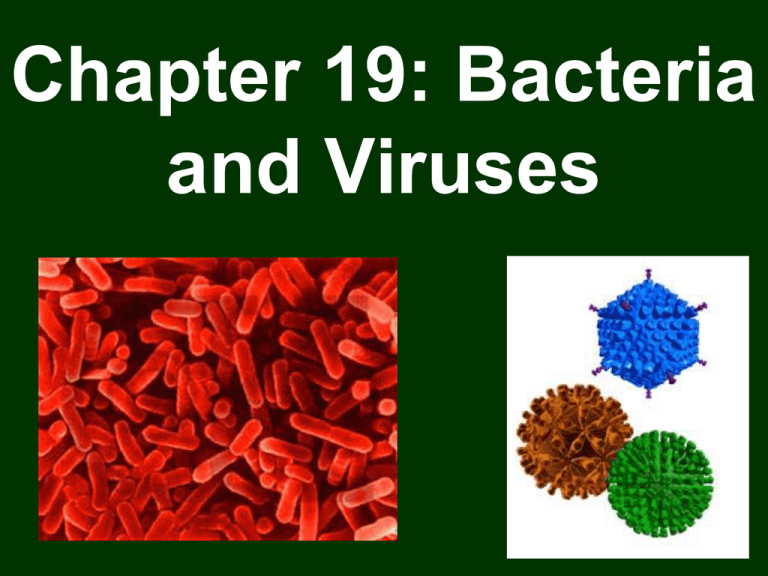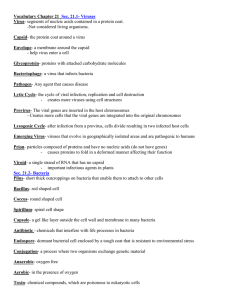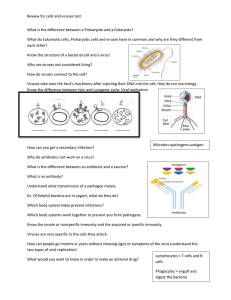Chapter 19: Bacteria and Viruses
advertisement

Chapter 19: Bacteria and Viruses Viruses • Means “poison” in Latin • Nonliving • Composed of nucleic acids enclosed in a protein coat • Smaller than bacteria (can vary in structure and size) • Can only replicate – Make copies of itself – Need a host/living cell to reproduce • No cell respiration, growth, response to stimuli – Not considered a living cell 1935: W. Stanley • 1st to identify a virus • Tobacco Mosaic Virus Structure of a Virus • Inner core of nucleic acid (DNA or RNA) • Outer protein coat called a capsid – Gives virus its shape • Some viruses have a membrane (envelope) over the capsid – Can have spikes, hooks, etc. Bacteriophage • Special group of viruses • Infect bacteria • Inject their nucleic acid into bacteria like a syringe Viruses are classifies by the type of host they infect • Plant viruses • Animal viruses • Bacterial viruses Viruses are often species-specific • Some are cell-type specific –Ex: cold viruses affect respiratory cells –Ex: Polio virus affects nerve cells 2 Types of Reproduction • Lytic cycle (short): takes about 30 minutes to produce 200 new viruses – Virus enters cell reproduces exits cell • Kills host cell: causes host cell to break open – Steps: ex: cold virus • attachment • entry • replication • assembly • lysis and release Lysogenic Cycle (long) • Virus has an inactive (dormant) period • Steps: ex: herpes, HIV, and chickenpox – attachment and entry – provirus formation (prophage) • viral DNA integrated into host’s chromosomes – normal cell activity – activation of the lytic cycle Retrovirus • RNA virus with the enzyme reverse transcriptase • Makes viral DNA from host cell RNA • Ex: HIV Fighting Viruses • Natural defenses – Skin, mucus membranes, white blood cells, antibody production, interferon • Vaccines – Preparation of weakened or killed virus/viral proteins – Some produce life-long specific antibodies – Antibiotics do not kill viruses How Viruses are Spread • Air (measles, cold) • Food and water (hepatitis) • Animal/insect bites (rabies, encephalitis) • Insects (flies can “carry” viruses) • Sexual contact (HIV, Herpes) • 1st line of defense skin and membranes Chapter 19 Review #1 1. A typical virus has a core composed of ___. a. capsid proteins b. surface proteins c. membrane envelopes d. DNA or RNA 2. The outer layer of a virus is composed of ____. a. RNA b. viral genes c. DNA d. proteins 3. A(an) _____ is a preparation of weakened or killed pathogens that can prompt the body to produce immunity to a disease. Bacteria • Prokaryotic: –Unicellular organisms –Have no nucleus –No membranebound organelles Divided into 2 Kingdoms Archaebacteria • Live in extreme habitats (usually no oxygen present) • Cell walls lack peptidoglycan (starch) • 3 types: – Methanogens • Produce methane gas • Live in marshes, lake sediments, and cow digestive tracts • Found at sewage disposal plants to help break down sewage Extreme Halophiles • Lives only in places where there is a high salt concentration • Found in Utah’s Great Salt Lakes and the Dead Sea Thermoacidophiles • Lives in hot, acidic waters of sulfur springs • Found in volcanic vents Eubacteria • Live almost everywhere • Cell walls made of peptidoglycan • Divided up based on how they get their food – Autotrophs • Make their own food • 2 types: – Photosynthetic » Need sunlight » Ex: cyanobacteria (blue-green algae) – Chemosynthetic » Use sulfur and nitrogen to make food Eubacteria • Heterotrophs – Use others/consumes to get food – 2 ways: • Parasitism, mutualism, commensalism – Gets food from other living things • Saprophytes – Feed on dead organisms/wastes – Decomposers Structure of Bacteria • Very small in size • All have: Some have: • DNA Pili • Cell membrane Capsule • Cell wall Flagella • Ribosomes – Genes are in a big circular chromosome (not paired chromosomes) • Cell wall keeps bacteria from bursting – Most bacteria live in a hypotonic environment – 1928: Alexander Fleming • Accidentally discovered Penicillin –1st antibiotic –Destroys bacteria by interfering with its ability to make a cell wall Identifying Bacteria • Gram Staining – Based on differences in a bacterium’s cell wall – Gram positive: will stain a blue/purple color – Gram negative: will stain a pink color Shapes of Bacteria • Bacteria have 3 shapes: – Cocci: sphereshaped – Bacilli: rod-shaped – Spirilla: spiralshaped Bacteria can grow in patterns • Diplo-: arranged in pairs • Staphylo-: cells arranged like grapes • Strepto-: arrangement of chains of cells Asexual Reproduction • Binary Fission • Exponential growth: 12481632 …etc • Very fast (every 20 minutes) • Cells produced are genetically identical Sexual Reproduction • Called conjugation • DNA is exchanged through structures called pili that connect cells together Metabolism • Breaking down food to release energy • 3 groups of bacteria based on way they metabolize: –Obligate aerobes: require oxygen • Ex: Mycobacterium tuberculosis • Facultative anaerobes: can live with or without oxygen – Ex: E. coli • Obligate anaerobes: die in the presence of oxygen – Ex: Clostridium, Treponema Importance of Bacteria • Help fertilize fields • Recycles nutrients: breakdown dead materials/waste (called saprophytes) • Produce foods and medicines/antibiotics • Nitrogen fixation: makes a usable form of nitrogen Harmful Bacteria: called pathogens • Can cause disease in plants and animals –Interferes with normal body function –Affects homeostasis –Can release a toxin that attacks the host (like a poison) Survival Adaptations • Produce endospores – Contain bacterial DNA and cytoplasm – Covered with a tough, outer case that resists temperature extremes, drying out, and harsh chemicals – Dormant: resting state (can be as long as 1,000 years) • Does not reproduce during this time • Can germinate when environmental conditions improve – Must be exposed to high heat under pressure to be killed • Called sterilization Chapter 19 Review #2 1. A ______ is a disease-causing agent. 2. List 4 ways to identify prokaryotes. 3. One way to control bacterial growth is by subjecting them to great heat, a process called _____. 4. Bacteria can also cause disease by releasing ______ that harm the body.







